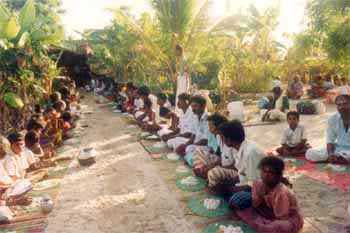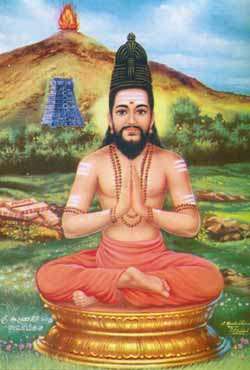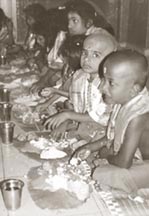|
| |||||||
 Annadānam from Kailāsa to KataragamaBy Swami Vigyananand and Patrick Harrigan
|
 |
Long before history came to be recorded, people the world over have recognized the close association between food and life. Human society may be said to have its roots in the systematic sharing of food.
In Oriental culture, the sharing of food has long been considered as a sacred duty. We offer cooked food to our ancestors, to the devas, to the Buddha and to monks, elders, pilgrims, as well as to family, friends, visitors, and to anyone who feels hunger, including animals. In Oriental tradition, no one should go to bed hungry; even animals and unseen beings should be offered food to ensure their happiness and good will.
The Sanskrit word annadānam literally means the offering or sharing (dānam) of food (annam). In every ethnic and religious community across the Indian subcontinent, no festival or ceremony is complete without annadānam, or at least with the distribution of prasādam, the edible items offered during pūjā.
Theory and practice
Accordingly, the importance of food is stressed in ancient scriptures, including the Vedas, Upanisads, Dharma Sastras, Dhamma Pāda, etc. Taittiriya Upanishad declares, ‘All life force comes from food.' (annam vai prānah) and ‘Let food be produced in plenty' (annam bahu kurveet). In Bhagavad Gita, Śrī Krishna declares, ‘From food all beings are evolved' (annād bhavanti bhūtāni).
Even simple folk practices preserve traditions that have endured since time immemorial. Ancient peoples believed that spirits or deities may move upon the earth in human guise, and that such beings possess special powers or abilities that may help those who are open-hearted and generous towards such unusual strangers.
Hence, it is considered prudent in traditional societies to regard every stranger or sudden visitor with the utmost courtesy, respect, and hospitality–including the offering of choice food items.
Manu Dharma Sastra's aphorism ‘atithih devo bhava' (‘regard the guest as a deity') plainly expresses this worldwide tradition among ancient societies that deities may move upon the earth in human guise, and that one should therefore regard them with the utmost courtesy and respect.
Annadānams too are conducted with this very principle in mind, for among the hungry crowd there may also be the anonymous genuine devotee, saint or even a deva or deity. Indeed, each and every poor person is regarded in this way, as expressed in the Sanskrit saying daridra Nārāyana (‘God dwells in the poor person').
Annadānam and Pada Yātrā
Just as as the Indian subcontinent may be said to extend from Mount Kailāsa in the far North to Kataragama in the far South (also called Dakshina Kailāsa as it is situated upon the same meridian as Mount Kailāsa), so also the principle of annadānam is respected and practiced across the subcontinent.
A popular saying among Kailāsa pilgrims Bābā Amarnātha barfāni bhukhe ko anna pyāse ko pāni exhorts listeners to ‘offer food to the hungry and water to the thirsty in the name of Lord Siva'.
Adi Sankarācharya in his stotram praising Annapūrnā, the personification of plentiful food, says:
Annapūrne sadāpūrne Sankarprānvallabhe gyānvairāgya siddhyartham bhiksham dehi ca Pārvati.
Annapūrnā Devi, Goddess of Plenty, you who are Lord Shiva's eternal Consort, give us alms together with wisdom.'
Because of this universal tradition of annadānam, since millennia it has been possible–even common–for sadhus, pilgrims, saints and others to travel from one end of the subcontinent to the other spreading the wisdom of their respective sampradayas to the far corners of the subcontinent.
Annadānam in Sri Lanka
Unlike in India, where innumerable traditions of pada yātrā flourish, here in Sri Lanka there remains only one pada yātrā tradition (foot pilgrimage to destinations such as Śrī Pāda died out in the 20th Century). The traditional Pada Yātrā from Jaffna in the far North to Kataragama in the far South has for centuries been an annual affair attracting not only local pilgrims but also pilgrims from abroad, especially from India.
 |
Arunagiri Nathar
Seven centuries ago, one of these anonymous pilgrims (for not one diary or record of a pilgrim has ever been published), Arunagiri Nathar, was a great Tamil devotee of god Skanda-Murugan, who had set out to visit and sing the praise of every great shrine of the God.
Less than a tenth of Arunagiri Nathar's reputed 16,000 Tiruppukal songs have survived. But from the few that survive, one can surmise that, like so many pilgrims before him, Arunagiri Nathar first visited Kiri Malai on the northern coast of the Jaffna peninsula where he sang Tiruppukal, proceeded by foot to Trincomalee where he sang at Tiru Konamalai.
Arunagiri Nathar may have sang Tiruppukal at other shrines as well, but it was only at his destination, Kataragama, that he sang the most verses, of which 14 still survive.
Arunagiri Nathar therefore was one among the traditional pada yātrā pilgrims of his day who annually walked for two months from Jaffna via Trincomalee to Kataragama in time for the great Esala (Adi) festival.
While en route to Kataragama, Arunagiri accepted annadanam from common villagers and, in return, sang his spontaneous verses of Tiruppukal. The subtle spiritual influence (āsirvādam) of pada yātris like Arunagiri Nathar, however invisible, should not be discounted or underestimated.
The yatris all carry the God's blessings with them to a lesser or greater extent, and it is principally for this aim that villagers offer annadānam. When one happens perchance (or by God's grace) to feed a great soul (like Arunagiri Nathar), the blessings continue to manifest for generations afterward.
|
|
Annadānam at Kataragama
In times past there have been many annadānam madams in Kataragama, and even today one may savour food offered freely to pilgrims and general public by Buddhists, Hindus, and Muslims at Kataragama.
Just as in human society, where the lady of the house serves guests with food, so also at Kataragama it is the God's eternal consort Śrī Theivayanai Amman whose madam feeds every visitor, regardless of from where they come. Because of this tradition, and because the Kataragama Esala Festival attracts hundreds of thousands of visitors annually, Śrī Theivayanai Ammann Madam today is Sri Lanka's largest annadānam madam.
Śrī Theivayanai Amman Annadanam Sabha preserves the Devasthanam's age-old tradition of serving annadanam to pilgrims from far off places. Most of the foot pilgrims to Kataragama rely upon Theivayanai Amman Devasthanam especially for their daily meals.
During the current Esala festival season, about 8,000-10,000 pilgrims daily enjoy tasty vegetarian lunches and dinners at Śrī Theivayanai Amman Devasthanam in addition to tea in the mornings and evenings. Even outside of festival times, the Devasthanam continues to serve annadanam the year round to devotees of all communities.
The Annadanam Sabha is pleased to render annadanam service to the public within the Temple premises of Śrī Theivayanai Amman, the presiding deity who is Annapoorani – the Great Giver of Food. A unique feature of the annadanam is its being served the traditional way–on plantain leaves–to devotees of all communities, including service personnel.
The Annadanam Sabha is coordinated by S.T.S. Arulananthan, J.P. and A. Maduraiveeran, ably assisted by eminent persons from Colombo, Matale, Kandy, Batticaloa, Vavuniya, and Trincomalee, including Messrs. Swaminathan Karuppaiah, Shanmugarajah, and T. Rajah, to mention only a few of 300 annadanam contributors. Praise is also owed to the energetic service rendered by a volunteer force of youth from all over the island led by Ramesh Babu.
Śrī Theivayanai Amman Temple, Kataragama is offering annadanam of pure vegetarian food to the public during the Kataragama Esala Festival from 17 July flag-hoisting until water-cutting on 1 August 2004.
Śrī Theivayanai Amman gives yearly once darshan to devotees during Maha Perahera. This year Maha Perahera and Ambal Darshan occur on Saturday evening, 31 July.
Swami Vigyananand is the deputy to Kataragama Śrī Theivayanai Amman Devasthanam Madadhipathi and Trustee, Swami Purnanand Giri.
Patrick Harrigan is an American scholar-devotee who has walked the Kataragama Pada Yatra 18 times since 1972. Since 1989 he has been acting editor of the Kataragama Research Publications Project.
Theivani Amman Devasthanam home page | Kalyanagiri and the Kalyana Mandapa
The life of Pal Kudi Bawa of Kathirkamam | Kataragama Tevayani Amman Temple:
Its History and Traditions
| Living Heritage Trust ©2021 All Rights Reserved |
